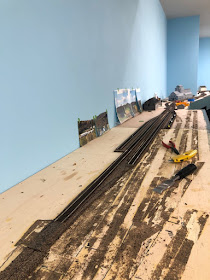In my last post on this project I'd gotten the basic building assembled. Next step is the roof. During my era the prototype had standing seam metal roofing. For this I used Evergreen styrene metal roofing (24" spacing).
This is a piece of styrene with grooves pre-milled the appropriate distance apart. Installation is pretty straightforward - cut the panels to shape, and then add the "ribs" - strips of styrene - to complete the roof.
This building has an L-shaped footprint, with an almost flat-roofed addition over the garage doors, meaning the roof panels are anything but simple rectangles. To get them sized properly I started with pieces of thin cardstock (actually the back of old memo pads) and cut them to the correct width.
Then I used a square to set the angle on the adjoining roof section and drew a line to get the angle correct. This wasn't as complicated as it sounds, but it did take some trial and error. I'm glad I did all this experimenting on the cardboard pieces and not the Evergreen sheets.
Once I was convinced the roof pieces looked correct, I used them as a pattern to cut out the styrene pieces.
 There were a few spots where I had to cut a slot in the styrene to permit the roof panel to fit and allow the gable end of the roof to extend past the vertical wall of the building. See the photo at left. I found it easier to cut the slots slightly too wide (toward the inside, it's important not to not have a gap between the roof and exterior wall. The slight gaps will be hidden by adjacent roof panels or flashing.
There were a few spots where I had to cut a slot in the styrene to permit the roof panel to fit and allow the gable end of the roof to extend past the vertical wall of the building. See the photo at left. I found it easier to cut the slots slightly too wide (toward the inside, it's important not to not have a gap between the roof and exterior wall. The slight gaps will be hidden by adjacent roof panels or flashing.  At this point the basic roof panels are in place. The next step is to add the "flashing" to the peaks and valleys using 1x6 strip styrene. Then I'll tackle the most tedious parts of building this style of roof - installing the ribs.
At this point the basic roof panels are in place. The next step is to add the "flashing" to the peaks and valleys using 1x6 strip styrene. Then I'll tackle the most tedious parts of building this style of roof - installing the ribs. Once that's done the roof will be ready for painting and weathering.










